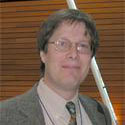Thomas Edison, Chemistry, and Cooper Union
Also posted at http://faculty.cooper.edu/topper/general/edison.html
Thomas Alva Edison, the famed American inventor, is well-known as having taught himself certain principles of chemistry as a young man (there are famous stories about his setting his basement and, later, a freight car on fire as a result of his early experiments). Given his lifelong interests in chemistry, it should come as no surprise that the one time Edison decided that he needed to enroll in a course at an institution of higher learning, he enrolled in a chemistry course at the Cooper Union.
In 1872, Edison was loaded with debt and has just struck out on his own with his new financial partner, Joseph T. Murray. Edison and his invention collaborator, Charles Batchelor were trying to develop new technologies for printing telegraphs. In November he was hired by the American Telegraph Works and the Automatic Telegraph Company to develop a functional automatic telegraphy system. He began by trying to improve an existing system developed by George Little which had never been functional, but ran into problems.
- "Alexander Bain, trying to circumvent Morse's patent, had discovered that when an electric current is passed through moistened paper the water is decomposed, and oxygen released. The oxygen instantaneously and minutely rusts a metal stylus. If a paper strip is impregnated with certain chemicals, the chemicals react with the rust to discolor the paper and form a mark. This reaction takes place at such infinite speed that it is possible to record a message chemically much faster than mechanically. In order not to infringe on Bain's patent, Little had had to devise a new chemical combination. But...
"'Little's solution is a failure. The worst we have ever thought of and got a mark from is better,' Batchelor exclaimed disgustedly. 'I can make as much mark with my fingernail.'
Neither Batchelor nor Edison had much knowledge of chemistry. Edison, however, was a firm believer that starting out with a clear head was not a handicap but an asset. He bought what chemistry books were available and enrolled in a class at Cooper Union in New York. [Cooper Union had been established by Peter Cooper, whose career as an inventor and manufacturer, predating Edison's by half a century, had many similarities. The school provides free instruction in the arts and sciences.] He and Batchelor set to work concocting solutions that would react with a metal stylus. At times they seemed more like cooks than chemists:
- 'Add teaspoonful of nitrate ammonia. To this, add what is held on small knifeblade of aurichloride of sodium.'
They tried all the known, and some unknown. iron solutions, but the highest speed they could attain was 150 words per minute, and the marks faded too quickly for practical recording. Experimenting with hundreds of different solutions over the period of a month, they found ferric cyanide of potassium superior to anything in use.
'Bully experiment!' Batchelor cried out on February 9, 1873 as they recorded perfectly on chemical paper at 250 words per minute, a speed that required the stylus to rust and be derusted 63 times a second.
'Now is the winter of our discontent made glorious summer by the son of York,' Batchelor transcribed, quoting from Shakespeare's Richard III. It was a phrase that would run over and over again through the experiments of Edison and Batchelor."
-Quoted from Robert Conot, Thomas A. Edison: A Streak of Luck (Da Capo Press, New York, 1979).
This page was compiled by Prof. Robert Topper, Department of Chemistry, The Cooper Union.

